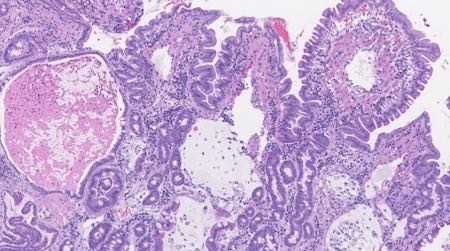Routine histopathological examinations include mandatory procedures for all biopsies arriving at the pathology laboratory.

It generally consists of the following 6 stages;
- Record
- macroscopy
- Tracing-Section-Painting
- microscopic examination
- Reporting
- Archiving
Incoming biopsies are first recorded. The registration process is a crucial and meticulous process in pathology laboratories. All registration processes in our laboratory are carried out in accordance with quality and accreditation procedures. During the registration process, each incoming sample is assigned a pathology number. This number is used during processing and archiving of the sample. While each laboratory has its own unique numbering system, the first incoming sample is generally numbered 1 at the beginning of each year (e.g., 1-2024).
The second stage of the laboratory's incoming samples is called macroscopy. It involves examining the incoming sample using all four senses (excluding taste) and taking samples from areas requiring microscopic examination. Our laboratory utilizes internationally recognized scientific resources, continuously training, and maintains its expertise to perform macroscopic examination, one of the most important stages of pathology services.
Samples obtained through macroscopic examination are then subjected to follow-up, casting, sectioning, and staining procedures. These steps are performed by trained and experienced pathology technicians. For an optimal microscopic examination, all these stages must be performed optimally. Our laboratory is constantly working to utilize up-to-date technological equipment and continuously improve the experience and training of its staff. Utmost care is taken to ensure compliance with quality and accreditation standards throughout all these stages.
Samples prepared for microscopic examination are examined by pathologists using a microscope. Microscopic examination refers to the microscopic examination of human tissue. This phase is performed in our laboratory by pathologists with academic experience, who are up-to-date on current scientific developments, respect ethical principles, and are committed to improving human health. The reporting phase is the process of documenting the data obtained from the microscopic examination. This phase requires the use of up-to-date scientific data. The report resulting from the examination should be prepared to address the patient's diagnosis, treatment, and follow-up. Our laboratory continuously updates report formats using internationally recognized scientific resources.
Patient samples, once examined and reported, are retained in the laboratory archives for a period specified in the Medical Laboratory Regulations published by the Ministry of Health. When archiving, samples are sorted by pathology number. Archiving allows for re-examination or consultation upon request.
Phone +90(216) 469 14 68
Mobile+90(535) 977 49 13
E-mail: info@marmarapatoloji.com


